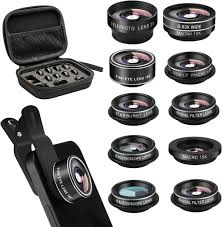Phone lenses are external accessories designed to enhance the photographic capabilities of smartphones. They attach to the phone’s camera and offer a variety of effects and improvements. Here’s a detailed look at phone lenses, including their types, uses, and considerations:
Types of Phone Lenses
Wide-Angle Lenses
- Purpose: Expand the field of view, allowing more of a scene to be captured in a single shot. Ideal for landscapes, group photos, and architectural photography.
- Features: Typically have a focal length shorter than the phone's built-in lens. They might provide a slight distortion at the edges, known as barrel distortion.
Macro Lenses
- Purpose: Allow close-up photography with greater detail. Perfect for capturing fine details of small objects like flowers, insects, or textures.
- Features: They enable focus at a very short distance from the subject, usually with magnification ratios that can range from 1x to 10x.
Telephoto Lenses
- Purpose: Provide a zoom effect to capture distant subjects more clearly. Useful for wildlife, sports, and portraits where you need to keep your distance from the subject.
- Features: They have a longer focal length compared to the phone's built-in lens, which allows them to magnify distant objects.
Fisheye Lenses
- Purpose: Create a hemispherical image with a wide field of view, often producing a distinctive spherical distortion. Great for artistic shots and unique perspectives.
- Features: Typically offer a 180-degree field of view, which causes the characteristic bulging effect.
Polarizing Lenses
- Purpose: Reduce glare and reflections from surfaces like water or glass. They can also enhance colors and contrast in bright conditions.
- Features: Often include a rotating ring to adjust the polarization effect.
Anamorphic Lenses
- Purpose: Produce a cinematic widescreen effect with unique lens flares and a wider aspect ratio. Popular in filmmaking and high-quality video production.
- Features: They compress the horizontal field of view and stretch it back to its original aspect ratio in post-production.
How Phone Lenses Work
- Attachment: Phone lenses are usually attached to the phone using a clip-on mechanism, magnetic mount, or a dedicated lens case. Some lenses come with adjustable clips that fit over the phone’s camera lens, while others may require a specific case designed for the lens.
- Optics: They use optical glass or high-quality plastic to refract light and achieve the desired effect. The quality of the lens can affect image sharpness and distortion.
- Compatibility: Ensure that the lens is compatible with your phone’s camera setup. Some lenses are designed for specific phone models or cases.
Considerations for Using Phone Lenses
- Image Quality: Higher-quality lenses tend to provide better clarity and less distortion. Cheap lenses might introduce more aberrations and affect overall image quality.
- Ease of Use: Some lenses can be cumbersome to attach and remove. Look for user-friendly designs and ensure that the lens does not obstruct the phone’s other functions.
- Portability: Consider the size and weight of the lens if you plan to carry it around frequently. Some lenses come with carrying cases or pouches for convenience.
- Lens Cleaning: Keep the lenses clean and free from scratches. Use a microfiber cloth to clean the lens surface regularly to maintain image quality.
Popular Brands and Models
- Moment: Known for high-quality lenses and accessories with a focus on professional-grade optics.
- Olloclip: Offers versatile lens kits that include wide-angle, macro, and fisheye lenses.
- Apexel: Provides budget-friendly options with a range of lens types, including macro and telephoto lenses.
- Sandmarc: Specializes in lenses for mobile photography with options for wide-angle, macro, and anamorphic lenses.
Phone lenses can greatly enhance the versatility of your smartphone camera, allowing for creative and professional-quality photography. Choose the lens type that best fits your photography needs and preferences.


No comments:
Post a Comment